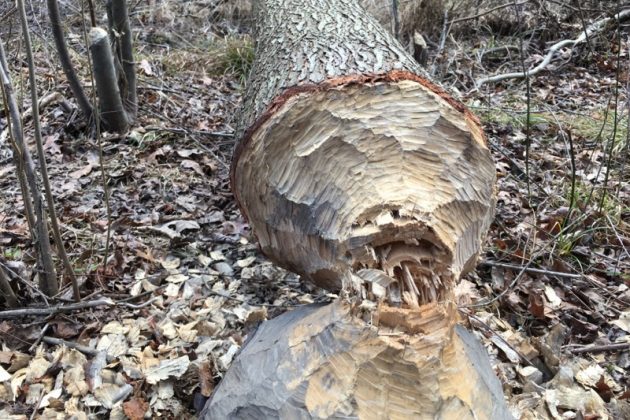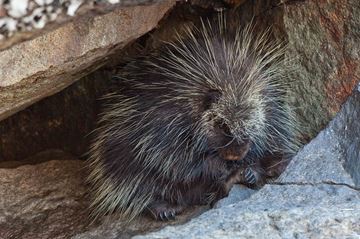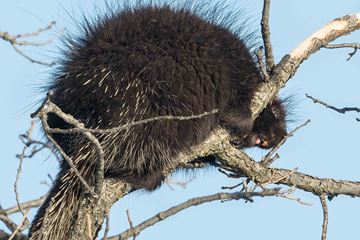Adrien Nelson of FBD didn’t make it to the conference this year, because he had work to do in Langley. And reading this you can tell he does it so well.
Fur-Bearers weigh in on Gloucester beaver trapping
The Association for the Protection of Fur-Bearing Animals is urging the Township to use alternative beaver management methods, after a dead beaver was found inside a trap in Gloucester last month.
Rather than trapping beavers — which according to Adrian Nelson, wildlife conflict manager with the Fur-Bearers, has only a 16 per cent success rate — a “long term solution” is using flow devices, such as pond levellers or exclusion fences.
Pond levellers are large pipes that allow water to flow through existing beaver dams, while exclusion fencing prevents beavers from accessing culverts or bridges.
“This is not new technology; they have been around for over 20 years, they are incredibly successful,” Nelson told Township council at its Feb. 20 evening meeting.
“When they are implemented properly we have a success rate of between 90 and 97 per cent, and that is over a 10-year period.”
The devices cost $400 to $600 in materials and take two people about half a day to install. They require maintenance twice per year, which usually consists of removing debris or garbage build-up. Nelson said the devices are much more cost-effective than repeatedly calling in trappers, or taking apart dams.
The Fur-Bearers also offer free training programs to municipal staff on how to implement and build the systems properly, having successfully worked with Mission, Coquitlam, Bowen Island, Surrey, Richmond, and even the Township of Langley.
Coun. David Davis, who has dealt with beavers on his farm many times, said he is concerned that during a rain event, a pipe through a beaver dam may not be able to handle the water coming through, and flooding would result, causing damage and costing the Township a lot of money. He believes in some cases, the beavers have to be removed.
Adrien is working hard in Langley to remind the city to do the right thing. Which they have done before but suddenly think might not work. And of course the council is making it as difficult as possible for obvious reasons. I feel these opponents have been well matched. And when I saw this letter to the editor I went so far as to say OVER matched. You will understand why.

Letter: Many humane options exist for managing beavers
Editor: I read the recent article in the paper (the Times, Jan. 18) about this wetland and the beavers, and thought I would send you this photo of my children Finley, 8, and Ruby, 5, with the beaver lodge in background and their art.
My children have joined Earth Rangers along with 100,000 other children across Canada and one of their missions was to speak with an elder about living with wildlife and do an art project.
We read about how the beaver represents wisdom. The beaver uses the gifts and knowledge it was given by the Creator to build a healthy and strong community.
In that process, it makes wetland habitat so we call them wetland superheroes.
This land was taken out of the ALR with the agreement that this area would be left as green space. With all the money that the government is putting toward wetland conservation, it would be a shame to lose this wetland and the beavers that made it.
I understand that there are many other management options that people could be using other than constantly killing them.
Well, all I can say is between Melissa, Ruby, Finley and Adrien, the stubborn city council doesn’t stand a chance. Keep it up! It takes a huge amount of protest to earn the right to inconvenience city staff, as we learned first hand in Martinez. They just hate being inconvenienced. Never mind, don’t let that stop you. There’s plenty of more child beaver artists where that came from if you need them. We should know.
One of the talks at the conference I wanted to hear the most was Lorne Fitch of Cows and Fish in Alberta. In fact we thought it was important enough that he be there that Worth A Dam paid his travel expenses and the Leonard Houston hosted him at the hotel. Unfortunately my fearless live recorders had to leave early yesterday to get back to Portland, but Journalist and soon-to-be author, Ben Goldfarb was kind enough to film the talk with his phone. This is an imperfect recording, but you can hear most all of what he has to say and see most of his slides, so I’m enormously grateful for the effort. Lorne represents the very best at involving the community and meeting disbelieving ranchers exactly where they are. If you have stubborn folk you want to persuade about beavers, (and who doesn’t?) he is the speaker you need to hear. I will try to get a copy of his ppt slides when he gets safely home. The first moments of the video are bumpy but it gets better so stick with it.








 I think it safe to say that everyone knows that beavers live in water, leaving its safety only to forage on land or to sleep inside a lodge. While they eat both aquatic and terrestrial herbaceous plants, through much of the year, especially in winter, much of their diet consists of the bark and twigs of trees, especially poplar.
I think it safe to say that everyone knows that beavers live in water, leaving its safety only to forage on land or to sleep inside a lodge. While they eat both aquatic and terrestrial herbaceous plants, through much of the year, especially in winter, much of their diet consists of the bark and twigs of trees, especially poplar. Apart from starvation and falling out of trees, Porcupines face another challenge. Some are shot by humans because they damage trees; others die when they cross highways or stop to glean salt from the asphalt. Porcupines are slow moving animals built for climbing, not running, and thus are prone to being hit by cars. They need not run from predators because they own a powerful defence: modified hairs known as quills.
Apart from starvation and falling out of trees, Porcupines face another challenge. Some are shot by humans because they damage trees; others die when they cross highways or stop to glean salt from the asphalt. Porcupines are slow moving animals built for climbing, not running, and thus are prone to being hit by cars. They need not run from predators because they own a powerful defence: modified hairs known as quills.







































